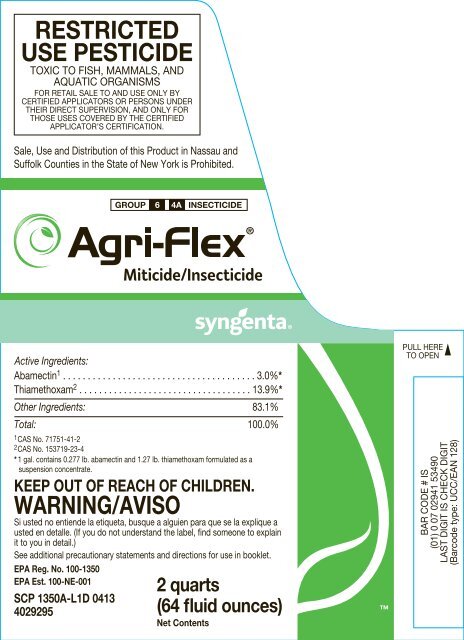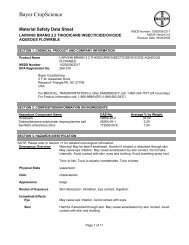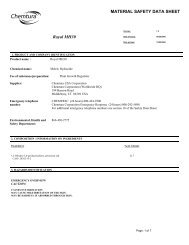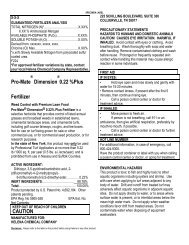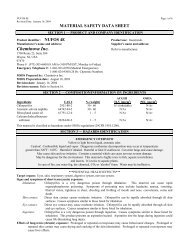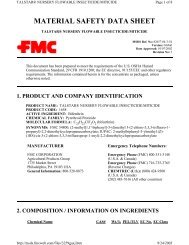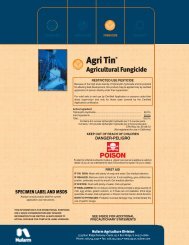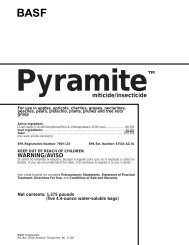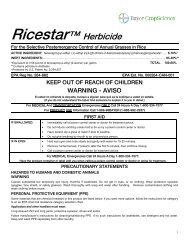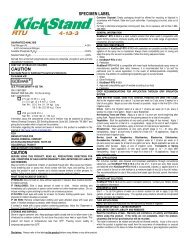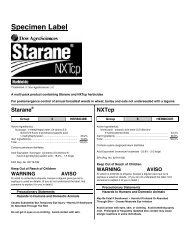Agri-Flex Miticide/Insecticide - Greenbook.net
Agri-Flex Miticide/Insecticide - Greenbook.net
Agri-Flex Miticide/Insecticide - Greenbook.net
You also want an ePaper? Increase the reach of your titles
YUMPU automatically turns print PDFs into web optimized ePapers that Google loves.
RESTRICTED<br />
USE PESTICIDE<br />
TOXIC TO FISH, MAMMALS, AND<br />
AQUATIC ORGANISMS<br />
FOR RETAIL SALE TO AND USE ONLY BY<br />
CERTIFIED APPLICATORS OR PERSONS UNDER<br />
THEIR DIRECT SUPERVISION, AND ONLY FOR<br />
THOSE USES COVERED BY THE CERTIFIED<br />
APPLICATOR’S CERTIFICATION.<br />
Sale, Use and Distribution of this Product in Nassau and<br />
Suffolk Counties in the State of New York is Prohibited.<br />
GROUP 6 4A INSECTICIDE<br />
®<br />
Active Ingredients:<br />
Abamectin 1 . . . . . . . . . . . . . . . . . . . . . . . . . . . . . . . . . . . . . . . 3.0%*<br />
Thiamethoxam 2 . . . . . . . . . . . . . . . . . . . . . . . . . . . . . . . . . . . 13.9%*<br />
Other Ingredients: 83.1%<br />
Total: 100.0%<br />
1CAS No. 71751-41-2<br />
2CAS No. 153719-23-4<br />
* 1 gal. contains 0.277 lb. abamectin and 1.27 lb. thiamethoxam formulated as a<br />
suspension concentrate.<br />
KEEP OUT OF REACH OF CHILDREN.<br />
WARNING/AVISO<br />
Si usted no entiende la etiqueta, busque a alguien para que se la explique a<br />
usted en detalle. (If you do not understand the label, find someone to explain<br />
it to you in detail.)<br />
See additional precautionary statements and directions for use in booklet.<br />
EPA Reg. No. 100-1350<br />
EPA Est. 100-NE-001<br />
SCP 1350A-L1D 0413<br />
4029295<br />
2 quarts<br />
(64 fluid ounces)<br />
Net Contents<br />
PULL HERE<br />
TO OPEN<br />
BAR CODE # IS<br />
(01) 0 07 02941 53490<br />
LAST DIGIT IS CHECK DIGIT<br />
(Barcode type: UCC/EAN 128)
If inhaled<br />
If swallowed<br />
If in eyes<br />
If on skin or<br />
clothing<br />
FIRST AID<br />
• Move person to fresh air.<br />
• If person is not breathing,<br />
call 911 or an ambulance,<br />
then give artificial respiration,<br />
preferably by mouth-tomouth,<br />
if possible.<br />
• Call a poison control center or<br />
doctor for further treatment<br />
advice.<br />
• Call poison control center or doctor<br />
immediately for treatment advice.<br />
• Have person sip a glass of water if<br />
able to swallow.<br />
• Do not induce vomiting unless told to<br />
do so by the poison control center or<br />
doctor.<br />
• Do not give anything by mouth to an<br />
unconscious person.<br />
• Hold eye open and rinse slowly and gently<br />
with water for 15-20 minutes.<br />
• Remove contact lenses, if present, after the<br />
first 5 minutes, then continue rinsing eye.<br />
• Call a poison control center or doctor for treatment<br />
advice.<br />
• Take off contaminated clothing.<br />
• Rinse skin immediately with plenty of water for<br />
15-20 minutes.<br />
• Call a poison control center or doctor for treatment<br />
advice.<br />
NOTE TO PHYSICIAN<br />
Early signs of intoxication include dilation of pupils, muscular incoordination, and muscular tremors. Toxicity<br />
following accidental ingestion of this product can be minimized by early administration of chemical adsorbents<br />
(e.g., activated charcoal).<br />
If toxicity from exposure has progressed to cause severe vomiting, the extent of resultant fluid and electrolyte<br />
imbalance should be gauged. Appropriate supportive parenteral fluid replacement therapy should be given,<br />
along with other required supportive measures (such as maintenance of blood pressure levels and proper<br />
respiratory functionality) as indicated by clinical signs, symptoms, and measurements.<br />
In severe cases, observations should continue for at least several days until clinical condition is stable and<br />
normal. Since abamectin is believed to enhance GABA activity in animals, it is probably wise to avoid drugs<br />
that enhance GABA activity (barbiturates, benzodiazepines, valproic acid) in patients with potentially toxic<br />
abamectin exposure.<br />
Have the product container or label with you when calling a poison control center or doctor, or going for<br />
treatment.<br />
HOT LINE NUMBER<br />
For 24-Hour Medical Emergency Assistance (Human or Animal)<br />
Or Chemical Emergency Assistance (Spill, Leak, Fire or Accident),<br />
Call<br />
1-800-888-8372
PRECAUTIONARY<br />
STATEMENTS<br />
Hazards to Humans and Domestic Animals<br />
WARNING/AVISO<br />
May be fatal if inhaled. Do not breathe spray<br />
mist. Harmful if swallowed or absorbed through<br />
the skin. Causes moderate eye irritation. Avoid contact<br />
with skin, eyes, or clothing. Wash thoroughly<br />
with soap and water after handling and before eating,<br />
drinking, chewing gum, using tobacco, or using<br />
the toilet. Remove and wash contaminated clothing<br />
before reuse.<br />
Personal Protective Equipment<br />
Applicators and other handlers must wear:<br />
• Long-sleeved shirt and long pants<br />
• Shoes plus socks<br />
• Chemical-resistant gloves made of any waterproof<br />
material – Category A (e.g., natural rubber ≥ 14mils)<br />
Discard clothing and other absorbent materials that have been<br />
drenched or heavily contaminated with this product’s concentrate.<br />
DO NOT reuse them. Follow manufacturer’s instructions for<br />
cleaning/maintaining PPE. If no such instructions for washables,<br />
use detergent and hot water. Keep and wash PPE separately from<br />
other laundry.<br />
Engineering Controls<br />
When handlers use closed systems, enclosed cabs, or aircraft in a manner<br />
that meets the requirements listed in the Worker Protection Standard (WPS)<br />
for agricultural pesticides (40 CFR 170.240(d)(4-6), the handler PPE requirements may be reduced or modified<br />
as specified in the WPS.<br />
IMPORTANT: When reduced PPE is worn because a closed system is being used, handlers must be provided all<br />
PPE specified above for “applicators and other handlers” and have such PPE immediately available for use in<br />
an emergency, such as a spill or equipment break-down.<br />
User Safety Recommendations<br />
Users should:<br />
• Wash hands before eating, drinking, chewing gum, using tobacco, or using the toilet.<br />
• Remove clothing immediately if pesticide gets inside. Then wash thoroughly and put on clean clothing.<br />
Environmental Hazards<br />
This pesticide is toxic to fish, wildlife and aquatic invertebrates.<br />
Do not apply directly to water, to areas where surface water is present, or to intertidal areas below the mean<br />
high water mark. Do not apply when weather conditions favor drift from target areas. Do not contaminate<br />
water when disposing of equipment wash water or rinsate. This product is highly toxic to bees exposed to direct<br />
treatment on blooming crops or weeds. Do not apply this product or allow it to drift to blooming crops or weeds<br />
while bees are foraging in/or adjacent to the treatment area.
Use of this product may pose a risk to threatened<br />
and endangered species of fish, amphibians,<br />
crustaceans (including fresh water shrimp),<br />
and insects. All use of this product in the state of<br />
California should comply with the recommendations<br />
of the California Endangered Species Project.<br />
Before using this product in California, consult with<br />
your county agriculture commissioner to determine<br />
use limitations that apply in your area.<br />
Surface Water Advisory<br />
This product may impact surface water quality due to<br />
spray drift and runoff of rain water. This is especially true<br />
for poorly draining soils and soils with shallow ground<br />
water. This product is classified as having high potential for<br />
reaching surface water via runoff for several months after<br />
application. A level, well-maintained vegetative buffer strip<br />
between areas to which this product is applied and surface<br />
water features such as ponds, streams, and springs will reduce<br />
the potential loading of thiamethoxam water from runoff<br />
water and sediment. Runoff of this product will be reduced by<br />
avoiding applications when rainfall is forecast to occur within 48<br />
hours. (see manual at the following Inter<strong>net</strong> address:<br />
http://www.wsi.nrcs.usda.gov/products/W2Q/pest/core4.html<br />
Ground Water Advisory<br />
<strong>Agri</strong>-<strong>Flex</strong> <strong>Miticide</strong>/<strong>Insecticide</strong> contains the active ingredients abamectin<br />
and thiamethoxam. Thiamethoxam has properties and characteristics<br />
associated with chemicals detected in ground water. This chemical<br />
may leach into the ground water if used in areas where soils are permeable,<br />
particularly where the water table is shallow.<br />
Attention: This product contains a chemical known to the State of California to<br />
cause birth defects or other reproductive harm.<br />
CONDITIONS OF SALE AND LIMITATION OF WARRANTY AND LIABILITY<br />
NOTICE: Read the entire Directions for Use and Conditions of Sale and Limitation of Warranty and Liability<br />
before buying or using this product. If the terms are not acceptable, return the product at once, unopened,<br />
and the purchase price will be refunded.<br />
The Directions for Use of this product must be followed carefully. It is impossible to eliminate all risks inherently<br />
associated with the use of this product. Crop injury, ineffectiveness or other unintended consequences may result<br />
because of such factors as manner of use or application, weather or crop conditions, presence of other materials or<br />
other influencing factors in the use of the product, which are beyond the control of SYNGENTA CROP PROTECTION,<br />
LLC or Seller. To the extent permitted by applicable law, Buyer and User agree to hold SYNGENTA and Seller harmless<br />
for any claims relating to such factors.<br />
SYNGENTA warrants that this product conforms to the chemical description on the label and is reasonably fit for<br />
the purposes stated in the Directions for Use, subject to the inherent risks referred to above, when used in accordance<br />
with directions under normal use conditions. To the extent permitted by applicable law: (1) this warranty<br />
does not extend to the use of the product contrary to label instructions, or under conditions not reasonably foreseeable<br />
to or beyond the control of Seller or SYNGENTA, and (2) Buyer and User assume the risk of any such use.<br />
TO THE EXTENT PERMITTED BY APPLICABLE LAW, SYNGENTA MAKES NO WARRANTIES OF MERCHANTABILITY<br />
OR OF FITNESS FOR A PARTICULAR PURPOSE NOR ANY OTHER EXPRESS OR IMPLIED WARRANTY EXCEPT AS<br />
WARRANTED BY THIS LABEL.
To the extent permitted by applicable law,<br />
in no event shall SYNGENTA be liable for<br />
any incidental, consequential or special damages<br />
resulting from the use or handling of<br />
this product. TO THE EXTENT PERMITTED BY<br />
APPLICABLE LAW, THE EXCLUSIVE REMEDY<br />
OF THE USER OR BUYER, AND THE EXCLUSIVE<br />
LIABILITY OF SYNGENTA AND SELLER FOR ANY<br />
AND ALL CLAIMS, LOSSES, INJURIES OR DAMAGES<br />
(INCLUDING CLAIMS BASED ON BREACH OF<br />
WARRANTY, CONTRACT, NEGLIGENCE, TORT, STRICT<br />
LIABILITY OR OTHERWISE) RESULTING FROM THE<br />
USE OR HANDLING OF THIS PRODUCT, SHALL BE THE<br />
RETURN OF THE PURCHASE PRICE OF THE PRODUCT<br />
OR, AT THE ELECTION OF SYNGENTA OR SELLER, THE<br />
REPLACEMENT OF THE PRODUCT.<br />
SYNGENTA and Seller offer this product, and Buyer and<br />
User accept it, subject to the foregoing Conditions of Sale<br />
and Limitation of Warranty and Liability, which may not<br />
be modified except by written agreement signed by a duly<br />
authorized representative of SYNGENTA.<br />
DIRECTIONS FOR USE<br />
RESTRICTED USE PRODUCT<br />
It is a violation of Federal law to use this product in a manner<br />
inconsistent with its labeling.<br />
RESTRICTIONS<br />
• Do not apply this product in a way that will contact workers or other<br />
persons, either directly or through drift. Only protected handlers are<br />
allowed in the area during application. For any requirements specific to<br />
your State or Tribe, consult the agency responsible for pesticide regulation.<br />
• Sale, use and distribution of this product in Nassau and Suffolk counties in the state of New York is prohibited.<br />
• In New York State, do not exceed a total of 0.188 lb. a.i. of thiamethoxam-containing products per acre per<br />
growing season.<br />
AGRICULTURAL USE REQUIREMENTS<br />
Use this product only in accordance with its labeling and with the Worker Protection Standard, 40 CFR part 170.<br />
This Standard contains requirements for the protection of agricultural workers on farms, forests, nurseries, and<br />
greenhouses, and handlers of agricultural pesticides. It contains requirements for training, decontamination,<br />
notification, and emergency assistance. It also contains specific instructions and exceptions pertaining to the<br />
statements on this label about personal protective equipment (PPE) and restricted-entry interval. The requirements<br />
in this box only apply to uses of this product that are covered by the Worker Protection Standard.<br />
Do not enter or allow worker entry into treated areas during the restricted-entry interval (REI) of 12 hours.<br />
Exception: For grape girdling, cane turning, and tying in grapes, do not enter or allow worker entry into<br />
treated areas during the restricted-entry interval (REI) of 4 days.<br />
PPE required for early entry to treated areas that is permitted under the Worker Protection Standard and that<br />
involves contact with anything that has been treated, such as plants, soil, or water is:<br />
• Coveralls over short pants and short-sleeved shirt<br />
• Chemical-resistant gloves made of any waterproof material – Category A (e.g., natural rubber ≥ 14mils)<br />
• Shoes plus socks
FAILURE TO FOLLOW DIRECTIONS AND<br />
PRECAUTIONS ON THIS LABEL MAY RESULT IN<br />
CROP INJURY, POOR PEST CONTROL, AND/OR<br />
ILLEGAL RESIDUES.<br />
USE INFORMATION<br />
<strong>Agri</strong>-<strong>Flex</strong> <strong>Miticide</strong>/<strong>Insecticide</strong> is an aqueous-based soluble<br />
concentrate that will control specified pests on the crops<br />
listed on this label when the product is applied according<br />
to the Crop Use Directions. Thorough coverage of foliage is<br />
essential for good mite and insect control.<br />
NOTE:<br />
• Adjuvant Requirement: To avoid illegal crop residues,<br />
<strong>Agri</strong>-<strong>Flex</strong> <strong>Miticide</strong>/<strong>Insecticide</strong> must always be mixed<br />
with a non-phytotoxic non-ionic activator type wetting,<br />
spreading and/or pe<strong>net</strong>rating spray adjuvant or horticultural<br />
oil (not a dormant oil) as specified in the Directions<br />
for Use for each crop on this label. Non-ionic activator<br />
type wetting, spreading and/or pe<strong>net</strong>rating spray adjuvants<br />
include non-ionic surfactants (NIS) with at least 75% surface<br />
active agent and crop oil concentrates (COC), vegetable oil<br />
concentrates (VOC), methylated seed/vegetable oils (MSO) and<br />
organosilicones (OS) with at least 15% emulsifiers/surfactants<br />
and include blends of these non-ionic activator type spray adjuvants.<br />
Spray adjuvants must be compatible with <strong>Agri</strong>-<strong>Flex</strong> and must<br />
be used at concentrations specified on the spray adjuvant product<br />
label directions for use for the targeted crop unless more specific<br />
directions are provided in the Directions for Use for individual crops<br />
on this label. Do not use binder or sticker type adjuvants because<br />
these type adjuvants may reduce translaminar movement of the active<br />
ingredient into the plant. SYNGENTA recommends the use of a Chemical<br />
Producers and Distributors Association-certified spray adjuvant.<br />
• Phytotoxicity and Tank Mix Compatibility: <strong>Agri</strong>-<strong>Flex</strong> <strong>Miticide</strong>/<strong>Insecticide</strong> has been tested for phytotoxicity and<br />
has a wide margin of safety on a variety of crops. <strong>Agri</strong>-<strong>Flex</strong> <strong>Miticide</strong>/<strong>Insecticide</strong> has also been tested and shown<br />
to have broad physical, biological and non-phytotoxic compatibility with many commonly used pesticides,<br />
spray adjuvants, and nutritional products. However, since it is not possible to test all potential mixtures, it is<br />
recommended that the user contact the supplier of all desired tank mix products for advice and/or pre-test,<br />
prior to commercial application, any previously unproven proposed mixtures with <strong>Agri</strong>-<strong>Flex</strong> <strong>Miticide</strong>/<strong>Insecticide</strong>.<br />
Conduct a jar test for physical compatibility of all components of the proposed mixture using proper concentrations<br />
of each mixture component. Pre-test the proposed mixture on a small area of the target crop under<br />
environmental and application conditions similar to the intended commercial application to ensure physical,<br />
biological, and non-phytotoxic compatibility. <strong>Agri</strong>cultural products formulated with binder or sticker type<br />
components may reduce performance of <strong>Agri</strong>-<strong>Flex</strong> <strong>Miticide</strong>/<strong>Insecticide</strong>.<br />
• Adjuvant Phytotoxicity Precaution: Since <strong>Agri</strong>-<strong>Flex</strong> <strong>Miticide</strong>/<strong>Insecticide</strong> must always be mixed with a spray<br />
adjuvant as instructed in the directions above and spray adjuvants alone are known to cause phototoxicity<br />
to certain crops under certain environmental conditions, do not use <strong>Agri</strong>-<strong>Flex</strong> <strong>Miticide</strong>/<strong>Insecticide</strong> on a spray<br />
adjuvant sensitive crop unless the spray adjuvant supplier can confirm a known non-phytotoxic labeled use rate<br />
for the intended spray adjuvant on the target crop.<br />
• Chemigation: Do not apply this product through any type of irrigation system.<br />
SPRAY DRIFT<br />
Responsibility<br />
Avoiding spray drift at the application site is the responsibility of the applicator.<br />
The interaction of many equipment- and weather-related factors determines the potential for spray drift. The<br />
applicator is responsible for considering all of these factors when making application decisions.
NOTE: When states have more stringent<br />
regulations, they must be observed.<br />
Spray Drift Precautions for Application<br />
with Aircraft or Ground Application<br />
Equipment<br />
• Apply <strong>Agri</strong>-<strong>Flex</strong> <strong>Miticide</strong>/<strong>Insecticide</strong> only when<br />
wind velocity favors on-target product deposition<br />
(approximately 3 to 10 mph).<br />
• Do not apply with ground application equipment<br />
within 25 ft. of or with aircraft within 150 ft. of<br />
lakes, reservoirs, rivers, permanent streams, marshes,<br />
pot holes, natural ponds, estuaries, or commercial fish<br />
farm ponds.<br />
• Do not cultivate within 25 ft. of the aquatic area to<br />
allow growth of a vegetative filter strip.<br />
• Do not allow this product to drift onto non-target<br />
areas. Drift may result in illegal residues or injury to nontarget<br />
species. Risk of exposure to sensitive areas can be<br />
reduced by applying this product when the wind direction<br />
is away from the sensitive area.<br />
• Do not apply when the weather conditions may cause drift.<br />
• Avoid application when the temperature is high and/or the<br />
humidity is low. These conditions increase the evaporation of<br />
spray droplets and the likelihood of drift to aquatic areas.<br />
• Do not apply when wind speed or wind gusts are greater than 15<br />
mph.<br />
• Do not apply when wind speed is below 2 mph because wind<br />
direction will vary and there is a high potential for inversion.<br />
• Observe the following precautions when using ground application to<br />
spray tree crops in the vicinity of aquatic areas such as lakes, reservoirs,<br />
permanent streams, marshes, potholes, natural ponds, estuaries, or commercial<br />
fish ponds:<br />
°<br />
Do not apply <strong>Agri</strong>-<strong>Flex</strong> <strong>Miticide</strong>/<strong>Insecticide</strong> when weather<br />
conditions favor drift to aquatic areas<br />
°<br />
Do not apply within 110 ft. upwind of aquatic areas or when<br />
wind speed is above 8 mph.<br />
°<br />
Spray last 3 rows windward of aquatic areas using nozzles on<br />
one side only, with spray directed away from the aquatic areas.<br />
°<br />
Avoid spray going over tops of trees by adjusting or turning<br />
off top nozzles. Shut off nozzles on the side away from the<br />
grove/orchard when spraying the outside row. Shut off nozzles<br />
when turning at ends of row and passing tree gaps in rows.<br />
Spray Drift Precautions for Aerial Application<br />
Drift Management Requirements<br />
The following drift management requirements must be followed to avoid off-target movement from aerial applications<br />
to agricultural crops.<br />
• Outermost Nozzle Distance<br />
The distance of the outermost nozzles on the boom must not exceed 3 /4 the length of the wingspan or rotor.<br />
• Nozzle Direction<br />
Nozzles must always point backward parallel with the air stream and never be pointed downwards more than 45<br />
degrees.
• Maximum Wind Speed<br />
Do not apply when wind speed is greater<br />
than 15 mph.<br />
• Droplet Size<br />
The most effective way to reduce drift potential<br />
is to apply large droplets. The best drift management<br />
strategy is to apply the largest droplets that<br />
provide sufficient coverage and control. Applying<br />
larger droplets reduces drift potential but will not<br />
prevent drift if applications are made improperly,<br />
or under unfavorable environmental conditions. (See<br />
Wind, Temperature and Humidity, and Temperature<br />
Inversions.)<br />
• Controlling Droplet Size<br />
Volume<br />
Use high flow rate nozzles to apply the highest practical<br />
spray volume. Nozzles with higher rated flows produce<br />
larger droplets.<br />
Pressure<br />
Do not exceed the nozzle manufacturer’s recommended<br />
pressures. For many nozzle types, lower pressure produces<br />
larger droplets. When higher flow rates are needed, use<br />
higher flow rate nozzles instead of increasing pressure.<br />
Number of Nozzles<br />
Use the minimum number of nozzles that provide uniform coverage.<br />
Nozzle Orientation<br />
Orienting nozzles so that the spray is released parallel to the air<br />
stream produces larger droplets than other orientations and is the<br />
recommended practice. Significant deflection from horizontal will reduce<br />
droplet size and increase drift potential.<br />
Nozzle Type<br />
Use a nozzle type that is designed for the intended application. With most nozzle types, narrower spray<br />
angles produce larger droplets. Consider using low-drift nozzles. Solid-stream nozzles oriented straight back<br />
produce the largest droplets and the lowest drift.<br />
• Boom Length<br />
For some use patterns, reducing the effective boom length to less than 3 /4 of the wingspan or rotor length may<br />
further reduce drift without reducing swath width.<br />
• Application Height<br />
Applications should not be made at a height greater than 10 ft. above the top of the target plants unless a greater<br />
height is required for aircraft safety. Making applications at the lowest height that is safe reduces exposure of<br />
droplets to evaporation and wind.<br />
• Swath Adjustment<br />
When applications are made with a cross wind, the swath will be displaced downwind. Therefore, on the up and<br />
downwind edges of the field, the applicator must compensate for this displacement by adjusting the path of the<br />
aircraft upwind.<br />
• Wind<br />
Drift potential is lowest between wind speeds of 2-10 mph. However, many factors, including droplet size and<br />
equipment type, determine drift potential at any given speed. Application must be avoided below 2 mph due to<br />
variable wind direction and high inversion potential.
NOTE: Local terrain can influence wind<br />
patterns. Every applicator should be familiar<br />
with local wind patterns and how they affect<br />
spray drift.<br />
• Temperature and Humidity<br />
To compensate for evaporation when applying<br />
<strong>Agri</strong>-<strong>Flex</strong> <strong>Miticide</strong>/<strong>Insecticide</strong> in low relative humidity,<br />
set up equipment to produce larger droplets.<br />
Evaporation of droplets is most severe when conditions<br />
are both hot and dry.<br />
• Temperature Inversions<br />
<strong>Agri</strong>-<strong>Flex</strong> <strong>Miticide</strong>/<strong>Insecticide</strong> must not be applied during<br />
a temperature inversion because the potential for drift is<br />
high. Temperature inversions restrict vertical air mixing,<br />
and this causes small, suspended droplets to remain in a<br />
concentrated cloud. This cloud can move in unpredictable<br />
directions due to the light variable winds that are common<br />
during inversions. Temperature inversions are characterized<br />
by temperatures that increase with altitude and are common<br />
on nights with limited cloud cover and light to no wind.<br />
Inversions begin to form as the sun sets and often continue into<br />
the morning. Their presence can be indicated by ground fog;<br />
however, if fog is not present, the movement of smoke from a<br />
ground source or an aircraft smoke generator can also identify<br />
inversions. Smoke that layers and moves laterally in a concentrated<br />
cloud (under low wind conditions) indicates an inversion, while<br />
smoke that moves upward and rapidly dissipates, indicates good vertical<br />
air mixing.<br />
Resistance Management<br />
Some insect and mite pests are known to develop resistance to products after<br />
repeated use. Because resistance development cannot be predicted, the use of this product should conform to<br />
sound resistance management strategies established for the crop and use area. Syngenta encourages responsible<br />
product stewardship to ensure effective long-term control of the insects on this label.<br />
If resistance to this product develops in your area, this product, or other products with a similar mode of action,<br />
may not provide adequate control. If poor performance cannot be attributed to improper application or extreme<br />
weather conditions, a resistant strain of insect or mite may be present. If you experience difficulty with control<br />
and resistance is a reasonable cause, immediately consult your local company representative or agricultural advisor<br />
for the best alternative method of control for your area.<br />
<strong>Agri</strong>-<strong>Flex</strong> <strong>Miticide</strong>/<strong>Insecticide</strong> contains a Group 6 <strong>Insecticide</strong> (abamectin, belonging to the mectin class of chemistry)<br />
and a Group 4A insecticide (thiamethoxam, belonging to the neonicotinoid class of chemistry). Insect or mite<br />
biotypes with acquired or inherent resistance to Group 6 or Group 4A insecticides may eventually dominate the<br />
population if Group 6 or Group 4A insecticides are used repeatedly as the predominant method of control for<br />
targeted species. This may result in partial or total loss of control of those species by <strong>Agri</strong>-<strong>Flex</strong> <strong>Miticide</strong>/<strong>Insecticide</strong><br />
or other Group 6 or Group 4A insecticides.<br />
In order to maintain susceptibility to these classes of chemistry:<br />
• Avoid using Group 6 and/or Group 4A insecticides exclusively for season-long control of insect species with more<br />
than one generation per crop season.
• For insect species with successive or overlapping<br />
generations, apply <strong>Agri</strong>-<strong>Flex</strong> <strong>Miticide</strong>/<br />
<strong>Insecticide</strong> or other Group 6 and/or Group<br />
4A insecticides using a “treatment window”<br />
approach. A treatment window is a period of<br />
time as defined by the stage of crop development<br />
and/or the biology of the pests of concern.<br />
Within the treatment window, depending on the<br />
length of residual activity, there may either be<br />
single or consecutive applications (seed treatment,<br />
soil, foliar, unless otherwise stated) of the Group<br />
6 and/or Group 4A insecticides. Do not exceed the<br />
maximum <strong>Agri</strong>-<strong>Flex</strong> <strong>Miticide</strong>/<strong>Insecticide</strong> allowed per<br />
growing season. Following a treatment window of<br />
Group 6 or Group 4A insecticides, rotate to a treatment<br />
window of effective products with a different mode of<br />
action before using additional applications of Group 6<br />
or Group 4A insecticides.<br />
• A treatment window rotation, along with other IPM practices<br />
for the crop and use area, is considered an effective use<br />
strategy for preventing or delaying an insect or mite pest’s<br />
ability to develop resistance to these classes of chemistry.<br />
• If resistance is suspected, do not reapply <strong>Agri</strong>-<strong>Flex</strong> <strong>Miticide</strong>/<br />
<strong>Insecticide</strong> or other Group 6 or Group 4A insecticides.<br />
Other Resistance Management (IRM) practices include but<br />
are not limited to:<br />
• Incorporating IPM techniques into your insect or mite control<br />
program.<br />
• Avoiding treatment of successive generations of a target pest with<br />
<strong>Agri</strong>-<strong>Flex</strong> <strong>Miticide</strong>/<strong>Insecticide</strong>.<br />
• Monitoring treated insect populations for loss of field efficacy.<br />
• Using tank mixtures or premixes with insecticides or miticides from a different<br />
target site of action group, as long as the involved products are all registered for the same crop outlet and<br />
effective rates are applied.<br />
• Using labeled rates at the specified spray intervals.<br />
• Using non-chemical alternatives such as beneficial arthropods.<br />
• Using various cultural practices.<br />
For additional information on Resistance Management:<br />
• Contact your local extension specialist, certified crop advisor and/or product manufacturer for additional insect<br />
resistance management recommendations.<br />
• Visit the <strong>Insecticide</strong> Resistance Action Committee (IRAC) on the web at: http://www.irac-online.org.<br />
CROP USE DIRECTIONS<br />
Pollinator Precautions<br />
• <strong>Agri</strong>-<strong>Flex</strong> <strong>Miticide</strong>/<strong>Insecticide</strong> is highly toxic to bees exposed to direct treatment on blooming crops or weeds.<br />
• For apples, do not apply <strong>Agri</strong>-<strong>Flex</strong> <strong>Miticide</strong>/<strong>Insecticide</strong> after pre-bloom (early pink growth stage) or before<br />
post-bloom (petal fall growth stage).<br />
• For citrus, do not apply <strong>Agri</strong>-<strong>Flex</strong> <strong>Miticide</strong>/<strong>Insecticide</strong> during pre-bloom or during bloom when bees are<br />
actively foraging.<br />
• For pears, do not apply <strong>Agri</strong>-<strong>Flex</strong> <strong>Miticide</strong>/<strong>Insecticide</strong> after pre-bloom (green cluster stage) or before postbloom<br />
(petal fall growth stage).
• Do not apply <strong>Agri</strong>-<strong>Flex</strong> <strong>Miticide</strong>/<strong>Insecticide</strong><br />
or allow it to drift to blooming crops or<br />
weeds if bees are foraging in/or adjacent<br />
to the treatment area. This is especially critical<br />
if there are adjacent orchards that are<br />
blooming. (Refer to Spray Drift Precautions<br />
for additional information).<br />
• After an <strong>Agri</strong>-<strong>Flex</strong> <strong>Miticide</strong>/<strong>Insecticide</strong> application,<br />
wait at least 5 days before placing beehives<br />
in the treated field.<br />
• If bees are foraging in the ground cover and it<br />
contains any blooming plants or weeds, always<br />
remove flowers before making an <strong>Agri</strong>-<strong>Flex</strong><br />
<strong>Miticide</strong>/<strong>Insecticide</strong> application. This can be accomplished<br />
by mowing, disking, mulching, flailing, or<br />
applying a labeled herbicide.<br />
• Consult with your local cooperative extension service or<br />
state agency responsible for regulating pesticide use for<br />
additional pollinator safety practices.<br />
Apples<br />
Apply <strong>Agri</strong>-<strong>Flex</strong> <strong>Miticide</strong>/<strong>Insecticide</strong> using conventional dilute<br />
or concentrate ground application sprayers calibrated to deliver<br />
sufficient water for thorough coverage. Adjust gallons of spray<br />
per acre based on size and number of trees per acre and density of<br />
foliage. In any case, thorough coverage is essential for good spider<br />
mite and insect control.<br />
Apples<br />
Pests<br />
Apple aphid<br />
Apple grain aphid<br />
Comstock mealybug<br />
European apple sawfly<br />
European red mite<br />
Green peach aphid<br />
Leafhoppers<br />
Leafminers<br />
McDaniel spider mite<br />
Plum curculio<br />
Twospotted spider mite<br />
For Dilute<br />
Sprays 1<br />
fl. oz./<br />
100 gal.<br />
For<br />
Concentrate<br />
Sprays 2<br />
fl. oz./A<br />
Instructions<br />
1.5-2.0 5.5-8.5 • To avoid illegal residues, <strong>Agri</strong>-<strong>Flex</strong> <strong>Miticide</strong>/<strong>Insecticide</strong> must<br />
be mixed with a spray adjuvant. Horticultural spray oil (not<br />
a dormant oil) is recommended. Do not use binder or sticker<br />
type adjuvants. (See Use Information section found at the<br />
beginning of this <strong>Agri</strong>-<strong>Flex</strong> <strong>Miticide</strong>/<strong>Insecticide</strong> label and Use<br />
Restrictions below.)<br />
• Apply <strong>Agri</strong>-<strong>Flex</strong> <strong>Miticide</strong>/<strong>Insecticide</strong> when spider mite or<br />
insect thresholds are reached.<br />
• Make a second application, if needed, to maintain control.<br />
(See Use Restrictions below.)<br />
• Spider Mites: For best results, apply before a threshold of 5<br />
spider mites per leaf is reached.<br />
• Residual spider mite control with the combination of <strong>Agri</strong>-<br />
<strong>Flex</strong> <strong>Miticide</strong>/<strong>Insecticide</strong> with horticultural spray oil (not a<br />
dormant oil) is greater from spray deposits on newer leaves<br />
compared to older.<br />
• For best results, apply <strong>Agri</strong>-<strong>Flex</strong> <strong>Miticide</strong>/<strong>Insecticide</strong> for spider<br />
mite control in the tree development period extending from<br />
petal fall through 6 weeks following petal fall. (continued)
Apples (continued)<br />
Pests<br />
Recommended Rate<br />
When Using<br />
Horticultural Spray Oil<br />
(not a dormant oil)<br />
For Dilute<br />
Sprays 1<br />
fl. oz./<br />
100 gals.<br />
0.25% or<br />
1 gal./A<br />
For<br />
Concentrate<br />
Sprays 2<br />
fl. oz./A<br />
Minimum of<br />
1 gal./A<br />
Instructions<br />
(continued)<br />
• Leafminers: For best results, apply against egg (to control new<br />
hatch) and early sap feeder stages of first and second-generation<br />
tentiform leafminers when locally established thresholds have<br />
been reached. Do not apply during bloom.<br />
• Leafhoppers: Apply soon after petal fall.<br />
• Comstock Mealybug: Apply immediately following petal fall to<br />
control first generation crawlers.<br />
• Plum Curculio: Apply immediately following petal fall. Apply<br />
higher rates for heavy infestations. Additional applications of a<br />
different insecticide may be necessary if pest pressure continues.<br />
1 The rate of <strong>Agri</strong>-<strong>Flex</strong> <strong>Miticide</strong>/<strong>Insecticide</strong> per 100 gal. is based on a volume of 400 gal./A dilute spray.<br />
2 To determine the amount of product per acre for concentrate sprays, first determine the amount that would be<br />
required in a full cover dilute spray. Use the same amount of product/A in concentrate sprays as would be required<br />
for the dilute sprays to the same orchard/grove. This can result in use of less than 5.5 fl. oz./A on small trees.<br />
Use Restrictions – Apples<br />
• PHI: Do not apply within 35 days of harvest.<br />
continued…
Use Restrictions – Apples (continued)<br />
• Adjuvant Requirement: To avoid illegal residues,<br />
<strong>Agri</strong>-<strong>Flex</strong> <strong>Miticide</strong>/<strong>Insecticide</strong> must be<br />
mixed with a spray adjuvant as instructed<br />
in the Use Information section found at the<br />
beginning of this <strong>Agri</strong>-<strong>Flex</strong> <strong>Miticide</strong>/<strong>Insecticide</strong><br />
label. The spray adjuvant must be approved for<br />
use on the targeted apple variety. Carefully follow<br />
the Directions for Use and Precautions on the spray<br />
adjuvant label as well as the precautions in official<br />
local spray guides.<br />
°<br />
°<br />
When used alone or when other products<br />
are applied sequentially, the combination of<br />
<strong>Agri</strong>-<strong>Flex</strong> <strong>Miticide</strong>/<strong>Insecticide</strong> with horticultural<br />
spray oil can injure the fruit of certain<br />
apple varieties (e.g., russetting on lightskinned<br />
varieties such as Golden Delicious).<br />
Applying the combination of <strong>Agri</strong>-<strong>Flex</strong><br />
<strong>Miticide</strong>/<strong>Insecticide</strong> and horticultural spray<br />
oil fewer than 14 days before or after applying<br />
Captan® or other sulfur-containing products<br />
can result in phytotoxicity and crop loss.<br />
• Application Method: Ground application only. Do not apply<br />
with aircraft.<br />
• Amount of Water: Do not apply in less than 40 gal. of water/A.<br />
• Maximum Amount per Application: Do not apply more than 8.5<br />
fl. oz./A of <strong>Agri</strong>-<strong>Flex</strong> <strong>Miticide</strong>/<strong>Insecticide</strong> or more than 0.023 lb.<br />
a.i./A of any foliar-applied abamectin-containing products or more<br />
than 0.086 lb. a.i./A of any foliar-applied thiamethoxam-containing<br />
products per application.<br />
• Application Interval: If a second application is necessary, wait at least 21<br />
days before repeating application of <strong>Agri</strong>-<strong>Flex</strong> <strong>Miticide</strong>/<strong>Insecticide</strong> or any foliar-applied product containing<br />
abamectin. Wait at least 10 days before repeating application of any other foliar-applied product containing<br />
thiamethoxam.<br />
• Number of Applications: Do not make more than 2 applications of <strong>Agri</strong>-<strong>Flex</strong> <strong>Miticide</strong>/<strong>Insecticide</strong> or any foliarapplied<br />
abamectin-containing product per growing season.<br />
• Maximum Amount per Season: Do not apply more than 17.0 fl. oz./A of <strong>Agri</strong>-<strong>Flex</strong> <strong>Miticide</strong>/<strong>Insecticide</strong> or more<br />
than 0.047 lb. a.i./A of any foliar-applied abamectin-containing products or more than 0.258 lb. a.i./A of any<br />
foliar-applied thiamethoxam-containing products per growing season. In New York State, do not exceed 0.172<br />
lb. a.i./A of any foliar-applied thiamethoxam-containing products per growing season on apples.<br />
• Grazing: Do not allow livestock to graze in treated orchards.
Citrus Fruit Crop Group<br />
Crops in this group are: Calamondin, Citrus<br />
citron, Citrus hybrids (includes chironja, tangelo,<br />
tangor), Grapefruit, Kumquat, Lemon,<br />
Lime, Mandarin (tangerine), Sour orange, Sweet<br />
orange, Pummelo, and Satsuma mandarin.<br />
Thorough spray coverage is essential for good mite<br />
and insect control. Adjust gallons of spray per acre<br />
based on size and number of trees per acre as well as<br />
density of foliage.<br />
• Ground Application<br />
Apply using conventional dilute or concentrate<br />
ground application sprayers calibrated to deliver sufficient<br />
water for thorough coverage (or outside coverage<br />
for Asian citrus psyllid, citrus leafminer, or citrus thrips).<br />
• Aerial Application<br />
Aerial application is permitted only for control of citrus<br />
leafminer. With aerial application, the resulting level and<br />
duration of control of citrus leafminer could be less than<br />
with ground application. Aerial application to citrus is not<br />
approved in California.<br />
Citrus Fruit Crop Group<br />
Pests<br />
Aphids<br />
Armored scales<br />
Asian citrus psyllid 3<br />
Broad mite 3<br />
Citrus black fly<br />
Citrus bud mite 4<br />
Citrus leafminer 3<br />
Citrus root weevil adults<br />
Citrus rust mite 3<br />
Citrus thrips 5<br />
Crickets<br />
Fruit fly<br />
Grasshoppers<br />
Katydids<br />
Leafhoppers<br />
Mealybugs<br />
Plant bugs<br />
Sharpshooters<br />
Soft scales<br />
Stink bugs<br />
Twospotted spider mite<br />
Whiteflies<br />
For Dilute<br />
Sprays 1<br />
fl. oz./<br />
100 gal.<br />
For<br />
Concentrate<br />
Sprays 2<br />
fl. oz./A<br />
Instructions<br />
0.55-0.85 5.5-8.5 • To avoid illegal residues, <strong>Agri</strong>-<strong>Flex</strong> <strong>Miticide</strong>/<strong>Insecticide</strong> must<br />
be mixed with a spray adjuvant. It is recommended for best<br />
results that a minimum of 0.20% horticultural spray oil (not<br />
a dormant oil) be used in the spray mixture or not less than<br />
1.0 gal. of horticultural spray oil/A (except when specified<br />
differently in footnotes below). Do not use binder or sticker<br />
type adjuvants. (See Use Information section found at the<br />
beginning of this <strong>Agri</strong>-<strong>Flex</strong> <strong>Miticide</strong>/<strong>Insecticide</strong> label and Use<br />
Restrictions below.)<br />
• Asian Citrus Psyllid: Apply <strong>Agri</strong>-<strong>Flex</strong> <strong>Miticide</strong>/<strong>Insecticide</strong> to<br />
protect newly expanding foliage flush during the spring,<br />
summer or fall.<br />
• Mites: Apply when mites first appear during spring, summer,<br />
and/or fall.<br />
• Citrus Bud Mite: For best results, time the spray at “bud swell.”<br />
• Citrus Leafminer: Apply to protect new growth during spring,<br />
summer, or fall.<br />
• Citrus Thrips: Application targeted for citrus thrips will only<br />
control the current generation and must be correctly timed.<br />
Apply when economic thresholds have been reached (after<br />
egg hatch has begun – preferably early to mid-hatch).<br />
• Scales: Time the applications to coincide with the crawler<br />
stage and within 14 days of initiation of crawler stage.<br />
continued…
1 The rate of <strong>Agri</strong>-<strong>Flex</strong> <strong>Miticide</strong>/<strong>Insecticide</strong> per<br />
100 gal. is based on a volume of 1000 gal./A<br />
dilute spray.<br />
2 For concentrate sprays, adjust the dosage to<br />
apply an amount/A equal to that used in full<br />
cover dilute spray.<br />
3 Ground application: For best results, use 150-300<br />
gal./A of spray mix with a minimum of 3 gal./A of<br />
horticultural spray oil (not a dormant oil) and apply<br />
at a ground speed of 1 to 1.5 MPH.<br />
4 For best results, use a minimum of 400 gal./A of spray<br />
mix with a minimum of 0.5% horticultural spray oil<br />
(not a dormant oil).<br />
5 For best results, use 100-250 gal./A of spray mix applied<br />
to achieve outside coverage.<br />
Use Restrictions – Citrus Fruit Crop Group<br />
• PHI: Do not apply within 7 days of harvest.<br />
• Adjuvant Requirement: To avoid illegal residues, <strong>Agri</strong>-<strong>Flex</strong><br />
<strong>Miticide</strong>/<strong>Insecticide</strong> must be mixed with a spray adjuvant<br />
as instructed in the Use Information section found at the<br />
beginning of this <strong>Agri</strong>-<strong>Flex</strong> <strong>Miticide</strong>/<strong>Insecticide</strong> label. The<br />
spray adjuvant must be approved for use on the intended<br />
target crop in the citrus crop group. Carefully follow the<br />
Directions for Use and Precautions on the adjuvant spray label<br />
as well as the precautions in official local spray guides. Refer to<br />
the Directions for Use table above for additional spray adjuvant<br />
instructions.<br />
• Application Method:<br />
°<br />
To control citrus leafminer - Ground or aerial application<br />
is permitted; however, do not apply with aircraft to<br />
citrus in California. For aerial application, use a minimum<br />
of 10 gallons of finished spray volume per acre. Under<br />
conditions such as high pest populations, dense foliage, or<br />
adverse application conditions (such as high temperatures),<br />
use a greater volume of water to ensure adequate coverage.<br />
°<br />
All other pests - Ground application only. Do not apply with<br />
aircraft.<br />
• Prohibited Use: To manage resistance, do not use in citrus nurseries.<br />
• Application Interval: Wait at least 30 days before repeating application of <strong>Agri</strong>-<strong>Flex</strong> <strong>Miticide</strong>/<strong>Insecticide</strong> or any<br />
foliar-applied product containing abamectin. Wait at least 7 days before repeating application of any other<br />
foliar-applied thiamethoxam-containing product.<br />
• Maximum Amount per Application: Do not apply more than 8.5 fl. oz./A of <strong>Agri</strong>-<strong>Flex</strong> <strong>Miticide</strong>/<strong>Insecticide</strong> or<br />
more than 0.023 lb. a.i./A of any foliar-applied abamectin-containing products or more than 0.086 lb. a.i./A of<br />
any foliar-applied thiamethoxam-containing products per application.<br />
• Maximum Amount per Season: Do not apply more than 17.0 fl. oz./A of <strong>Agri</strong>-<strong>Flex</strong> <strong>Miticide</strong>/<strong>Insecticide</strong> or more<br />
than 0.047 lb. a.i./A of any foliar-applied abamectin-containing products or more than 0.172 lb. a.i./A of any<br />
foliar-applied thiamethoxam-containing products per growing season.<br />
• Do not make more than 3 applications of <strong>Agri</strong>-<strong>Flex</strong> <strong>Miticide</strong>/<strong>Insecticide</strong> or any foliar-applied abamectin-containing<br />
product per growing season.<br />
• Grazing: Do not allow livestock to graze in treated orchards.
Grapes<br />
Apply <strong>Agri</strong>-<strong>Flex</strong> <strong>Miticide</strong>/<strong>Insecticide</strong> using conventional ground sprayers<br />
calibrated to deliver sufficient water for thorough coverage.<br />
Thorough coverage is essential for good spider mite and insect control.<br />
Do not spray alternate rows. <strong>Agri</strong>-<strong>Flex</strong> <strong>Miticide</strong>/<strong>Insecticide</strong> must be<br />
applied to both sides of each row for maximum coverage.<br />
Grapes<br />
Pests fl. oz./A Instructions<br />
Japanese Beetle<br />
Mealybugs<br />
Pacific spider mite<br />
Sharpshooters<br />
Twospotted spider mite<br />
Variegated leafhopper<br />
Western grape leafhopper<br />
Western grapeleaf skeletonizer<br />
Willamette spider mite<br />
4.5-5.5 • To avoid illegal residues, <strong>Agri</strong>-<strong>Flex</strong> <strong>Miticide</strong>/<strong>Insecticide</strong> must be mixed<br />
with a non-ionic activator type wetting, spreading and/or pe<strong>net</strong>rating<br />
spray adjuvant. Do not use binder or sticker type adjuvants. (See<br />
Use Information section found at the beginning of this <strong>Agri</strong>-<strong>Flex</strong><br />
<strong>Miticide</strong>/<strong>Insecticide</strong> label and Use Restrictions below.)<br />
• Use 4.5 - 5 fl. oz./A for low to moderate infestations and 5.5 fl. oz.<br />
for high infestations.<br />
• Repeat application, if needed. (See Use Restrictions below.)<br />
• Spider mites: Apply when mites first appear but before motiles<br />
exceed 5 per leaf.<br />
• Western grapeleaf skeletonizer: Apply <strong>Agri</strong>-<strong>Flex</strong> <strong>Miticide</strong>/<strong>Insecticide</strong><br />
when larvae are first observed. For optimum control, apply shortly<br />
after egg hatch.<br />
Use Restrictions – Grapes<br />
• PHI: Do not apply within 28 days of harvest.<br />
• Adjuvant Requirement: To avoid illegal residues, <strong>Agri</strong>-<strong>Flex</strong> <strong>Miticide</strong>/<strong>Insecticide</strong> must be mixed with a non-ionic<br />
activator type wetting, spreading and/or pe<strong>net</strong>rating spray adjuvant as instructed in the Use Information section<br />
found at the beginning of this <strong>Agri</strong>-<strong>Flex</strong> <strong>Miticide</strong>/<strong>Insecticide</strong> label. The spray adjuvant must be approved for use<br />
on the targeted grape variety. Although <strong>Agri</strong>-<strong>Flex</strong> <strong>Miticide</strong>/<strong>Insecticide</strong> has been tested in combination with a<br />
range of non-ionic activator type wetting, spreading and/or pe<strong>net</strong>rating spray adjuvants for safety to grapes, it is<br />
impossible to test <strong>Agri</strong>-<strong>Flex</strong> <strong>Miticide</strong>/<strong>Insecticide</strong> with all potential spray adjuvants on all grape varieties under the<br />
variety of conditions that could cause crop injury. Therefore, when using <strong>Agri</strong>-<strong>Flex</strong> <strong>Miticide</strong>/<strong>Insecticide</strong> carefully<br />
follow the Directions for Use and Precautions on the spray adjuvant label and in official local spray guides. Do<br />
not use binder-sticker type adjuvants.<br />
continued…
Use Restrictions – Grapes (continued)<br />
• Application Method: Ground application<br />
only.<br />
• Amount of Water:<br />
°<br />
Do not apply in less than 50 gal. of<br />
water/A with conventional ground<br />
application equipment.<br />
°<br />
When using an electro-static sprayer,<br />
less than 50 gal. of water/A can be<br />
used, however do not use less than 5<br />
gal. of water/A.<br />
• Maximum Amount per Application: Do not apply<br />
more than 5.5 fl. oz./A of <strong>Agri</strong>-<strong>Flex</strong> <strong>Miticide</strong>/<strong>Insecticide</strong><br />
or more than 0.019 lb. a.i./A of any foliar-applied<br />
abamectin-containing products or more than 0.055 lb.<br />
a.i./A of any foliar-applied thiamethoxam-containing<br />
products per application.<br />
• Application Interval: If a second application is necessary,<br />
wait at least 21 days before repeating application of<br />
<strong>Agri</strong>-<strong>Flex</strong> <strong>Miticide</strong>/<strong>Insecticide</strong> or any foliar-applied product<br />
containing abamectin. Wait at least 14 days before repeating<br />
application of any other foliar-applied product containing<br />
thiamethoxam.<br />
• Number of Applications: Do not make more than 2 applications<br />
of <strong>Agri</strong>-<strong>Flex</strong> <strong>Miticide</strong>/<strong>Insecticide</strong> or any foliar-applied abamectincontaining<br />
product per growing season.<br />
• Maximum Amount per Season: Do not apply more than 11.0 fl. oz./A<br />
of <strong>Agri</strong>-<strong>Flex</strong> <strong>Miticide</strong>/<strong>Insecticide</strong> or more than 0.038 lb. a.i./A of any<br />
foliar-applied abamectin-containing products or more than 0.11 lb. a.i./A<br />
of any foliar-applied thiamethoxam-containing products per growing season.<br />
• Grazing: Do not allow livestock to graze in treated vineyards.
Pears (including Oriental pear trees)<br />
Apply <strong>Agri</strong>-<strong>Flex</strong> <strong>Miticide</strong>/<strong>Insecticide</strong> using conventional dilute<br />
or concentrate ground application sprayers calibrated to deliver<br />
sufficient water for thorough coverage. Adjust gallons of spray per<br />
acre based on the size and number of trees per acre and density of<br />
foliage. In any case, thorough coverage is essential for good spider<br />
mite and insect control.<br />
Pears<br />
Pests<br />
Aphids<br />
European red mite<br />
Leafhoppers<br />
McDaniel spider mite<br />
Mealybugs<br />
Pear psylla<br />
Pear rust mite<br />
Plum Curculio<br />
Twospotted spider mite<br />
Yellow mite<br />
Horticultural Spray Oil<br />
(not a dormant oil)<br />
For Dilute<br />
Sprays 1<br />
fl. oz./<br />
100 gal.<br />
For<br />
Concentrate<br />
Sprays 2<br />
fl. oz./A<br />
Instructions<br />
1.5-2.0 5.5-8.5 • To avoid illegal residues, <strong>Agri</strong>-<strong>Flex</strong> <strong>Miticide</strong>/<strong>Insecticide</strong><br />
must be mixed with a spray adjuvant. Horticultural<br />
spray oil (not a dormant oil) is recommended. Do<br />
not use binder or sticker type adjuvants. (See Use<br />
Information section found at the beginning of this<br />
<strong>Agri</strong>-<strong>Flex</strong> <strong>Miticide</strong>/<strong>Insecticide</strong> label and Use Restrictions<br />
below.<br />
• Apply <strong>Agri</strong>-<strong>Flex</strong> <strong>Miticide</strong>/<strong>Insecticide</strong> when spider mite<br />
or insect thresholds are reached.<br />
• Make a second application, if needed, to maintain<br />
control. (See Use Restrictions below.)<br />
0.25% or<br />
1 gal./A<br />
Minimum of<br />
1 gal./A<br />
1 The rate of <strong>Agri</strong>-<strong>Flex</strong> <strong>Miticide</strong>/<strong>Insecticide</strong> per 100 gal. is based on a volume of 400 gal./A dilute spray.<br />
2 To determine the amount of product per acre for concentrate sprays, first determine the amount that would<br />
be required in a full cover dilute spray. Use the same amount of product/A in concentrate sprays as would be<br />
required for the dilute sprays to the same orchard/grove. This can result in use of less than 5.5 fl. oz./A on small<br />
trees.<br />
continued…
Use Restrictions – Pears<br />
• PHI: Do not apply within 35 days of harvest.<br />
• Adjuvant Requirement: To avoid illegal residues,<br />
<strong>Agri</strong>-<strong>Flex</strong> <strong>Miticide</strong>/<strong>Insecticide</strong> must be<br />
mixed with a spray adjuvant as instructed in<br />
the Use Information section found at the beginning<br />
of this <strong>Agri</strong>-<strong>Flex</strong> <strong>Miticide</strong>/<strong>Insecticide</strong> label.<br />
The spray adjuvant must be approved for use on<br />
pears. Carefully follow the Directions for Use and<br />
Precautions on the spray adjuvant label as well as<br />
the precautions in official local spray guides.<br />
°<br />
Applying the combination of <strong>Agri</strong>-<strong>Flex</strong><br />
<strong>Miticide</strong>/<strong>Insecticide</strong> and horticultural spray oil<br />
fewer than 14 days before or after applying<br />
Captan® or other sulfur-containing products<br />
can result in phytotoxicity and crop loss.<br />
• Application Method: Ground application only. Do not<br />
apply with aircraft.<br />
• Amount of Water: Do not apply in less than 40 gal. of<br />
water/A.<br />
• Maximum Amount per Application: Do not apply more than<br />
8.5 fl. oz./A of <strong>Agri</strong>-<strong>Flex</strong> <strong>Miticide</strong>/<strong>Insecticide</strong> or more than<br />
0.023 lb. a.i./A of any foliar-applied abamectin-containing<br />
products or more than 0.086 lb. a.i./A of any foliar-applied<br />
thiamethoxam-containing products per application.<br />
• Application Interval: If a second application is necessary, wait at<br />
least 21 days before repeating application of <strong>Agri</strong>-<strong>Flex</strong> <strong>Miticide</strong>/<br />
<strong>Insecticide</strong> or any foliar-applied product containing abamectin.<br />
Wait at least 10 days before repeating application of any other foliarapplied<br />
product containing thiamethoxam.<br />
• Number of Applications: Do not make more than 2 applications of <strong>Agri</strong>-<br />
<strong>Flex</strong> <strong>Miticide</strong>/<strong>Insecticide</strong> or any foliar-applied abamectin-containing product<br />
per growing season.<br />
• Maximum Amount per Season: Do not apply more than 17.0 fl. oz./A of <strong>Agri</strong>-<strong>Flex</strong> <strong>Miticide</strong>/<strong>Insecticide</strong> or more<br />
than 0.047 lb. a.i./A of any foliar-applied abamectin-containing products or more than 0.258 lb. a.i./A of any<br />
foliar-applied thiamethoxam-containing products per growing season. In New York State, do not exceed 0.172<br />
lb. a.i./A of any foliar-applied thiamethoxam-containing products per growing season on pears.<br />
• Grazing: Do not allow livestock to graze in treated orchards.<br />
STORAGE AND DISPOSAL<br />
Do not contaminate water, food, or feed by storage or disposal.<br />
Pesticide Storage<br />
Store in a tightly closed container in a cool, dry place.<br />
Pesticide Disposal<br />
Pesticide waste may be hazardous. Improper disposal of excess pesticide, spray mixture or rinsate is a violation<br />
of Federal Law. If these wastes cannot be disposed of by use according to label instructions, contact your State<br />
Pesticide or Environmental Control agency, or the Hazardous Waste representative at the nearest EPA regional<br />
Office for guidance.
Container Handling<br />
Non-refillable container. Do not reuse or refill this container.<br />
Triple rinse container (or equivalent) promptly after emptying.<br />
Triple rinse as follows: empty the remaining contents into application<br />
equipment or a mix tank and drain for 10 seconds after the<br />
flow begins to drip. Fill the container 1 /4 full with water and recap.<br />
Shake for 10 seconds. Pour rinsate into application equipment or a<br />
mix tank or store rinsate for later use or disposal. Drain for 10 seconds<br />
after the flow begins to drip. Repeat this procedure two more<br />
times. Offer for recycling if available or puncture and dispose of in a<br />
sanitary landfill, or by incineration, or by other procedures allowed by<br />
state and local authorities.<br />
<strong>Agri</strong>-<strong>Flex</strong>®, the ALLIANCE FRAME<br />
the SYNGENTA Logo and the PURPOSE ICON<br />
are Trademarks of a Syngenta Group Company<br />
Captan® is a trademark of Tomen Agro, Inc.<br />
©2013 Syngenta<br />
Manufactured for:<br />
Syngenta Crop Protection, LLC<br />
P.O. Box 18300<br />
Greensboro, North Carolina 27419-8300<br />
SCP 1350A-L1D 0413<br />
4029295<br />
For non-emergency (e.g., current product information) call<br />
Syngenta Crop Protection at 1-800-334-9481.
RESTRICTED USE PESTICIDE<br />
TOXIC TO FISH, MAMMALS, AND AQUATIC ORGANISMS<br />
FOR RETAIL SALE TO AND USE ONLY BY CERTIFIED APPLICATORS OR<br />
PERSONS UNDER THEIR DIRECT SUPERVISION, AND ONLY FOR THOSE<br />
USES COVERED BY THE CERTIFIED APPLICATOR’S CERTIFICATION.<br />
Sale, Use and Distribution of this Product in<br />
Nassau and Suffolk Counties in the<br />
State of New York is Prohibited.<br />
GROUP 6 4A INSECTICIDE<br />
®<br />
<strong>Miticide</strong>/<br />
<strong>Insecticide</strong><br />
Active Ingredients:<br />
Abamectin 1 . . . . . . . . . . . . 3.0%*<br />
Thiamethoxam 2 . . . . . . . . . 13.9%*<br />
Other Ingredients: 83.1%<br />
Total: 100.0%<br />
1CAS No. 71751-41-2<br />
2CAS No. 153719-23-4<br />
* 1 gal. contains 0.277 lb. abamectin<br />
and 1.27 lb. thiamethoxam<br />
formulated as a suspension<br />
concentrate.<br />
See additional precautionary<br />
statements and directions for use<br />
in booklet.<br />
AGRICULTURAL<br />
USE REQUIREMENTS<br />
Use this product only in accordance<br />
with its labeling and with<br />
the Worker Protection Standard,<br />
40 CFR part 170. Refer to supplemental<br />
labeling under “<strong>Agri</strong>cultural<br />
Use Requirements” in the<br />
Directions for Use section for<br />
information about this standard.<br />
EPA Reg. No. 100-1350<br />
EPA Est. 100-NE-001<br />
<strong>Agri</strong>-<strong>Flex</strong>® <strong>Miticide</strong>/<strong>Insecticide</strong><br />
and the SYNGENTA Logo<br />
are Trademarks of a<br />
Syngenta Group Company<br />
© 2013 Syngenta<br />
Manufactured for:<br />
Syngenta Crop Protection, LLC<br />
P.O. Box 18300<br />
Greensboro, NC 27419-8300<br />
SCP 1350A-L1D 0413<br />
4029295<br />
2 quarts<br />
(64 fluid ounces)<br />
Net Contents<br />
KEEP OUT OF<br />
REACH OF<br />
CHILDREN.<br />
WARNING/<br />
AVISO<br />
Si usted no entiende la etiqueta, busque a<br />
alguien para que se la explique a usted en<br />
detalle. (If you do not understand the label,<br />
find someone to explain it to you in detail.)<br />
PRECAUTIONARY STATEMENTS<br />
Hazards to Humans and Domestic Animals<br />
WARNING/AVISO<br />
May be fatal if inhaled. Do not breathe spray mist.<br />
Harmful if swallowed or absorbed through the skin. Causes<br />
moderate eye irritation. Avoid contact with skin, eyes, or clothing.<br />
Wash thoroughly with soap and water after handling and before eating, drinking, chewing gum, using<br />
tobacco, or using the toilet. Remove and wash contaminated clothing before reuse.<br />
FIRST AID<br />
If inhaled: Move person to fresh air. If person is not breathing, call 911 or an ambulance, then give artificial<br />
respiration, preferably by mouth-to-mouth, if possible. Call a poison control center or doctor for<br />
further treatment advice. If swallowed: Call poison control center or doctor immediately for treatment<br />
advice. Have person sip a glass of water if able to swallow. Do not induce vomiting unless told to do so<br />
by the poison control center or doctor. Do not give anything by mouth to an unconscious person. If in<br />
eyes: Hold eye open and rinse slowly and gently with water for 15-20 minutes. Remove contact lenses,<br />
if present, after the first 5 minutes, then continue rinsing eye. Call a poison control center or doctor for<br />
treatment advice. If on skin or clothing: Take off contaminated clothing. Rinse skin immediately with<br />
plenty of water for 15-20 minutes. Call a poison control center or doctor for treatment advice.<br />
NOTE TO PHYSICIAN: Early signs of intoxication include dilation of pupils, muscular incoordination,<br />
and muscular tremors. Toxicity following accidental ingestion of this product can be minimized by<br />
early administration of chemical adsorbents (e.g., activated charcoal).<br />
If toxicity from exposure has progressed to cause severe vomiting, the extent of resultant fluid<br />
and electrolyte imbalance should be gauged. Appropriate supportive parenteral fluid replacement<br />
therapy should be given, along with other required supportive measures (such as maintenance of<br />
blood pressure levels and proper respiratory functionality) as indicated by clinical signs, symptoms,<br />
and measurements.<br />
In severe cases, observations should continue for at least several days until clinical condition is stable<br />
and normal. Since abamectin is believed to enhance GABA activity in animals, it is probably wise to<br />
avoid drugs that enhance GABA activity (barbiturates, benzodiazepines, valproic acid) in patients with<br />
potentially toxic abamectin exposure.<br />
Have the product container or label with you when calling a poison control center or doctor, or going<br />
for treatment.<br />
HOT LINE NUMBER: For 24-Hour Medical Emergency Assistance (Human or Animal) Or Chemical<br />
Emergency Assistance (Spill, Leak, Fire or Accident), Call 1-800-888-8372.<br />
Refer to booklet for PPE.


